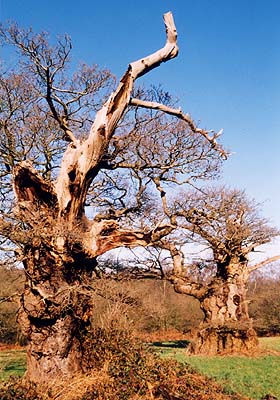
RBH Home
Maps & Travels
Articles
Legends
Towns & Villages
Castles & Houses
Churches
Biographies
Gentry
Family History
Odds & Ends
Mail David
 Windsor Castle
Windsor CastleThe Great Park
After the castle itself, the chief
glory of Windsor is the Great Park, the remnant of a tract of 180 miles in
circuit, which formed the happy hunting-ground of our medieval kings. It
is joined to the town and castle by the Long Walk, the noble avenue of
elms planted by Charles II. The Park is gently undulating and dotted, here and there, with
magnificent oaks and beeches, sometimes standing singly, sometimes in
thick clumps. Looking from George IV's Gateway to the gilt statue which he erected to "the best
of fathers," the beauty of the landscape thrills one with the
satisfaction of perfection. The spirit of romance seems to pervade each
fairy glade and hill, and visions of days long past arise before us, when
lord and lady fair on fiery steeds rode through the enchanted spot, and
paused in their pursuit of the bounding deer, moved by the genius of the
place, to whisper words of love. An oak measuring 26 feet 10 inches, at
the height of 5 feet from the ground, is reckoned to be 800 years old.
Three oaks in Cranbourne Chase, the oldest of which is probably 450 years,
are called respectively, Queen Anne, Queen Charlotte and Queen Victoria, these names it is scarcely necessary to explain, having
been given since they evolved from their sapling stage. Herne's Oak, which
Shakespeare memorialises in "The Merry Wives" was, according to some, blown
down in a storm in 1863 and a sapling was planted to mark the spot.
According to others, it was cut down by mistake, with other decayed trees,
by the order of George
III. At one corner of the Park, there are some dozen oak trees,
all as old as the Norman Conquest.
In fact, wherever one glances, be it at an old tree, or a bit of old
carving half hidden in grass, or a china cup in the drawing-room, or a
picture in the library, from the marble sarcophagus erected in memory of
the Prince Albert to a blade of grass on the terrace, one finds endless
cause for interest and deeper investigation. Such historical associations
cling to every stone or crumb of earth, such romantic stories are
whispered to one at every turn, such echoes of old-world times are
recalled at every foot-fall, that no one could weary of visiting again and
again this wondrous spot, to dream of bygone faces, fashions, and manners.
And as one gazes, one feels the same pride in its beauty as stirred the
hearts of Henry
III and Edward III; one
understands the desire of the world-satiated Henry
VIII to rest in peace by the side of his best loved queen under
those cool grey stones, and one feels a deep thankfulness that the
storm-tossed Charles is at rest for evermore in that calm, sanctified, world-remote spot.
Edited from PH
Ditchfield's "Bygone Berkshire" (1896)
